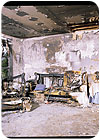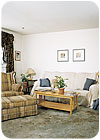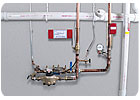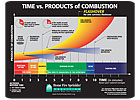
Photo of fire damage to a living room without a sprinkler. Courtesy of HFSC.
A national survey commissioned by the Society of Fire Protection Engineers and conducted in January 2008 by Synovate reveals that 79% of Americans feel safer from fires at home than in a public building. [The survey polled more than 1,000 American adults, and its findings have a margin of error of +/- 4%.] Yet statistics show that the fire problem in the U.S. is overwhelmingly a home fire problem.
According to the National Fire Protection Association (NFPA), homes account for about 80% of all fire deaths in a typical year and more than 95% of all deaths in structure fires in a typical year. Fire is the largest single cause of property loss in the United States. The NFPA reports $5.7 billion in direct property loss from fire in one- and two-family dwellings. This data suggests that any improvements in overall fire safety must be improvements in home fire safety.
According to the non-profit Home Fire Sprinkler Coalition (HFSC), fire sprinklers provide a level of protection that no other fire protection technology can offer. A residential sprinkler will activate from the heat of an early-stage fire (135

NFPA 13D: The Installation Standard
NFPA 13D is the installation standard for fire sprinkler systems in one- and two-family dwellings. It is referenced by the International Residential Code and by other model codes as the guide for installing residential sprinkler systems. The primary purpose is to save lives, and the goal is to provide 10 minutes of sprinkler flow, to allow occupants time to escape and the fire department to respond.In one- and two-family dwellings, NFPA 13D only requires sprinklers in an occupied space. Sprinklers are not required in smaller bathrooms or closets, garages, attached open structures like carports or porches, or attics. This helps keep the systems affordable. Statistics show that fires rarely start in these areas, and so the standard takes cost and practicality into consideration by not requiring installation there. In today’s building codes, garages are usually separated from the living quarters by some non-combustible materials like gypsum board.
As for design and installation, NFPA 13D recognizes two different approaches: stand-alone and multipurpose. A stand-alone system is a dedicated sprinkler system that doesn’t share piping with domestic plumbing fixtures. Multipurpose systems, on the other hand, have piping that serves both sprinklers and domestic plumbing fixtures. Each approach has unique advantages, which you can learn more about by reviewing NFPA 13D.
With respect to piping materials, plastic and copper piping are most commonly used. The two types of plastic that are permitted are chlorinated-polyvinyl chloride (or CPVC) and cross-linked polyethylene (or PEX). Plastic pipe has really simplified installation and made sprinkler systems cost-effective and quick to install.
In areas where freezing is a concern, NFPA 13D provides guidance for proper insulation and freeze protection, similar to other water piping in the home. A common approach to avoid installing pipe in the attic is the use of sidewall sprinklers in areas beneath an unfinished attic. Sprinklers typically operate off the household water main. When the water supply is a well, or there is not enough water pressure, a 300-gallon tank will be enough to supply the required 10 minutes of water.

A
typical riser found in a Chicago area home from a stand-alone system. The fire
sprinkler system does not go through the water meter, but a backflow is
required.
The Bad and The Good
With the increase in residential fire sprinkler installations, HFSC has experienced an increase in questions and requests specifically related to water supply. Most of the questions are about pipe size, water meters, backflow protection and concerns about tap fees.According to Gary Keith, HFSC Chair, lack of knowledge about the technology and the benefits of fire sprinkler protection, especially among water purveyors, can have far-reaching and damaging effects in communities that have growing residential sprinkler efforts underway. Keith said HFSC has learned about unfortunate cases where exorbitant tap fees are being charged to owners of sprinklered single-family homes.
“These unfair fees penalize the homeowner for a decision to enhance the safety of the home, and they negatively impact the entire community,” Keith said. “Recently, we heard from a single-parent who is building a home in Ohio who wants to install fire sprinklers to protect a young child with a disability. The water utility said there would be an additional $15,000 fee because a larger meter would be needed.”
According to HFSC, in addition to their life-safety abilities, fire sprinklers offer the water purveyor a cost-effective method of managing water usage. Without fire sprinklers, firefighters will use thousands of gallons of water to fight a home fire. With a fire sprinkler system, a few hundred gallons will be used to control or extinguish the fire. This efficient use of water translates into significant savings for the water purveyor, especially since the water used by firefighter hoses is not metered.
According to data from The Scottsdale Report (where data has been maintained since Scottsdale passed a fire sprinkler ordinance in 1986), the city of Scottsdale, AZ has saved an estimated $7.5 million in future infrastructure costs. Today, 50,000 Scottsdale homes are protected with fire sprinklers. One major cost-saving measure was allowing fire hydrants to be spaced further apart in the areas protected with fire sprinklers.
In general, fire sprinkler systems require very little maintenance. The sprinklers themselves require none at all. While NFPA 13D does not require a flow switch, it is recommended that systems with a flow switch and/or alarm be tested annually by the homeowner or the sprinkler contractor. Backflow prevention devices are not required by NFPA 13D.
Fire sprinklers can be roughed in anytime after the plumbing and HVAC installation and trimmed at the same time other contractors are working. In a large home, an entire sprinkler system can be installed in about a day or two.
Municipal officials often have the authority to offer valuable trade-up options for sprinklered developments. Trade-ups might include street width reduction, longer dead end streets, use of T turnarounds, increased grades and building setbacks, increased hydrant spacing and additional units. Some communities may also offer a reduction in fire-rated separation requirements.
The insurance industry banks on the fact that having installed fire sprinklers not only protects against fire injuries and deaths; they also protect against fire damage. As an incentive for customers, insurance companies offer discounts ranging from 5% to 30% off the fire portion of homeowner premiums.
No one knows better than first responders how quickly a home fire grows and spreads, becoming lethal to occupants as well as to firefighters. Since publication of the 1973 watershed national report America Burning, the fire safety field generally - and the fire service in particular - have been vocal advocates for increasing home fire sprinkler installations as a means to reduce residential fire injuries and deaths.

This is a chart HFSC uses to show the timing of a typical
residential fire: when the smoke alarm activates, when the sprinkler activates,
when flashover occurs and when the fire department arrives.
About the Home Fire Sprinkler Coalition
HFSC is the only non-profit, national organization working exclusively to educate the public about the life-saving value of installed residential fire sprinkler systems. HFSC develops a wide range of fire safety educational materials for consumers, members of the homebuilding industry, insurance and real estate professionals, and for the fire service to use in local educational outreach.Its mission is to provide accurate information to the public about the life-saving value of residential fire sprinkler protection, particularly in new construction of one- and two-family dwellings. Board Members include representatives from the American Fire Sprinkler Association, Canadian Automatic Sprinkler Association, Home Safety Council, International Association of Fire Chiefs, National Fire Protection Association, National Fire Sprinkler Association, State Farm Insurance, Underwriters Laboratories and U.S. Fire Administration.
The HFSC has developed educational material with details about home fire sprinkler systems, how they work, why they provide affordable protection and answers to common myths and misconceptions about their operation. These materials are provided at no charge and are available upon request by calling 888-635-7222 or at the HFSC Web site: www.homefiresprinkler.org.
HFSC recently introduced an interactive education program titled “Captain Splash and the Droplets” for grade school students and education programs for insurance agents, real estate agents and water purveyors.